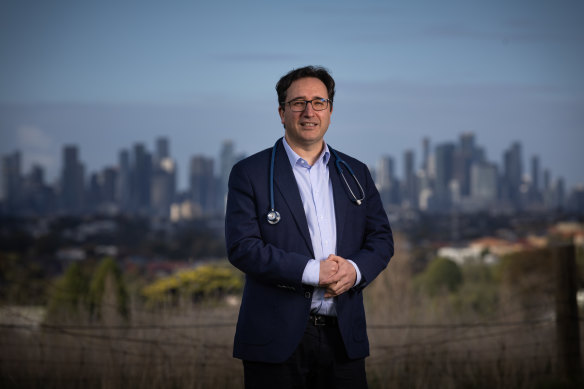Migrants in this Melbourne suburb prospered. But long life brings new challenges
By Aisha Dow, Henrietta Cook and Craig Butt
Avondale Heights has long been a hub for Italian migrants and their families in Melbourne’s western suburbs. It also has the highest rate of dementia in Victoria – a label that some say shows more about the community’s prosperity than its shortfalls.
As Dr Vincent Strangio, one of the local general practitioners, who grew up in the area, explained: “Age, you can’t beat it.”

Dr Vincent Strangio grew up around Avondale Heights and now works in the area.Credit: Jason South
His older patients, many of whom migrated to Australia after World War II searching for better job opportunities, built proud brick homes in quiet, winding streets. They are now living longer than ever before.
“Even 50 years ago, my grandparents wouldn’t have lived past their 60s,” said Strangio, who works at Centreway Medical Centre in neighbouring Keilor East. “I’ve one at 96 and one that just died at 99. That was unheard of back then.”
At 2.41 per cent of the community, Avondale Heights’ rate of dementia is more than three times the state average, an analysis of census data as part of this masthead’s State of Our Health series shows.
It’s a phenomenon that Strangio and his colleagues have mulled over before. He believes that, along with improved life expectancy, there are several dementia risk factors in the suburb, which has a median age of 45 – seven years older than the Victorian average – and where almost a quarter of the population has Italian ancestry.
Risk factors
The first set of risk factors relates to the change of lifestyle that occurred as migrants shifted from their European villages, where people generally walked everywhere and grew and farmed their own food, to Australian suburbia, with its more sedentary lifestyle.
And while Avondale Heights is still dotted with fruit trees and cottage gardens, Strangio said their traditional Mediterranean diet had incorporated less healthy additions such as processed white pasta and more sugary treats.
This can contribute to high blood pressure and higher cholesterol, which can cause heart attacks, strokes and vascular dementia.
In a final piece of the puzzle, Avondale Heights also has a number of residential aged care facilities, home to many dementia patients.
Dementia is used to describe several types of incurable and degenerative diseases that can affect people’s memory, thinking and behaviour, caused by abnormal brain changes.
There are significant risk factors for developing dementia that can’t be avoided, such as ageing (two in five Australians over 90 have dementia) and genetics. But experts believe that roughly 40 per cent of cases worldwide are caused by 12 modifiable risk factors, meaning they are potentially preventable.
These include lower levels of education, hypertension, obesity, alcohol, traumatic brain injury, hearing loss, smoking, depression, physical inactivity, social isolation, diabetes and air pollution.
“We know that what’s good for our heart is good for our brain,” said Maree McCabe, the chief executive of Dementia Australia.
“So looking after our vascular health is really important … It’s really important to live a healthy lifestyle, get in exercise [and] avoid excessive alcohol.”
The 2021 census data shows there are several Victorian communities where there are no or very few people living with dementia, including Port Melbourne, Eynesbury and Exford (south of Melton) and parts of Truganina and Tarneit, in Melbourne’s far west. All of these areas have populations younger than the state average.
However, University of Sydney healthy ageing expert Professor Lee-Fay Low said dementia should be on the radar of every community, as people needed to start thinking about their risk factors when they were younger, particularly in their 40s and 60s, to decrease their chances of developing the disease in older age.
“The evidence is that from midlife you need to look after your blood pressure. And I suspect with the exercise, the sooner you start doing it, the better.”
Australia’s age-standardised rate of deaths from dementia (which takes into account the country’s ageing population) has increased slightly in the last decade from 35 to 38 deaths per 100,000 people according to the Australian Institute of Health and Welfare.
However, Low said that this may not represent a real increase, but down to improved reporting of the still-stigmatised condition.
Low said it was estimated that up to 50 per cent of people with dementia had not yet had a formal diagnosis. This is a problem, she said, because it meant that people might be not accessing support services or drugs that can slow the progression of Alzheimer’s disease, the most common type of dementia.
“If it works for you, it will slow progression, conservatively, by about a year,” Low said. “Some of the evidence is saying more [than a year] … That’s a year where you could see your granddaughter get married, hold your grandbaby, go on a trip – a year makes a difference.”
The Morning Edition newsletter is our guide to the day’s most important and interesting stories, analysis and insights. Sign up here.